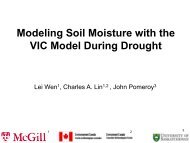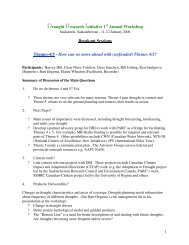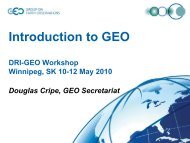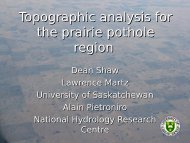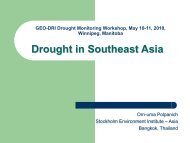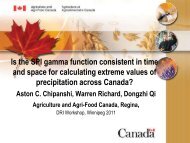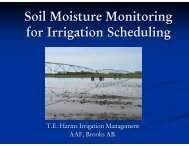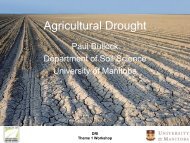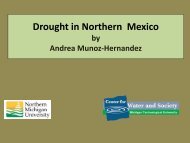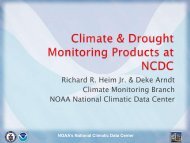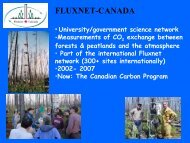Introduction to DRI (Ron Stewart) - Drought Research Initiative
Introduction to DRI (Ron Stewart) - Drought Research Initiative
Introduction to DRI (Ron Stewart) - Drought Research Initiative
Create successful ePaper yourself
Turn your PDF publications into a flip-book with our unique Google optimized e-Paper software.
The <strong>Drought</strong> <strong>Research</strong> <strong>Initiative</strong><br />
<strong>Ron</strong>ald <strong>Stewart</strong><br />
University of Mani<strong>to</strong>ba
SOME OF THE ISSUES<br />
• Will we see more droughts in the future<br />
• How will next season look<br />
• Will there be any break from the drought over<br />
the next few days<br />
And:<br />
• How can we better cope with drought
WATER AND ENERGY CYCLING<br />
<strong>Drought</strong> is an aberration in the<br />
Water and energy cycle
OBJECTIVES AND STRATEGY<br />
The objectives of <strong>DRI</strong> are:<br />
• To better understand the physical<br />
characteristics of and processes influencing<br />
Canadian Prairie droughts, and<br />
• To contribute <strong>to</strong> their better prediction and <strong>to</strong><br />
improved societal preparation<br />
Strategy:<br />
• Focus on the recent severe drought that<br />
began in 1999 and largely ended in 2005
TIMELINE OF <strong>DRI</strong><br />
2002: Dec Call for new Network LOIs by CFCAS<br />
2003: Feb Initial LOI submitted <strong>to</strong> CFCAS<br />
Nov Acceptance of LOI (3 y Network)<br />
2004: March 18-19 <strong>Drought</strong> workshop (5 y Network possible)<br />
Dec 19 Proposal submission<br />
2005: June 14 Proposal review<br />
August Proposal formally accepted<br />
2006: Jan 11-12 First workshop<br />
2007: Jan 11-13 Second workshop<br />
2008: Jan 17-19 Third workshop<br />
2009: Jan 26-28 Fourth workshop<br />
2009/10: Synthesis workshop, User workshops<br />
2010: May 12-14 Fifth workshop<br />
2011: Summer Completion of all network activities
The Canadian<br />
Prairies
PERIODS OF 1999-2005 DROUGHT
<strong>DRI</strong> THEMES<br />
1. Quantify the physical features,<br />
o flows of water and energy in<strong>to</strong> and out of the region, and<br />
o s<strong>to</strong>rage and redistribution within the region<br />
2. Improve the understanding of processes and feedbacks<br />
governing the<br />
o formation,<br />
o evolution,<br />
o cessation and<br />
o structure of the drought<br />
3. Assess and contribute <strong>to</strong> reducing uncertainties in the<br />
prediction of drought<br />
4. Compare the similarities and differences of current drought<br />
<strong>to</strong> previous droughts and those in other regions<br />
5. Apply our progress <strong>to</strong> address critical issues of importance<br />
<strong>to</strong> society
FINAL STATEMENTS<br />
At the end of <strong>DRI</strong>:<br />
• “We have greatly increased our understanding of<br />
drought through a focus on the recent 1999-2004/05<br />
one over the Prairies and we have applied this <strong>to</strong><br />
improved prediction.”<br />
• “We have left a legacy of comprehensive datasets,<br />
improved observational and modelling techniques, a<br />
new generation of drought scientists, and a public<br />
better educated about drought.”<br />
• “We have, in partnership with others in Canada and<br />
internationally, developed a plan <strong>to</strong> improve drought<br />
and water cycle prediction at multiple scales.”
<strong>DRI</strong> STATEMENT<br />
January 2009<br />
We have made substantial progress in<br />
unravelling the fac<strong>to</strong>rs controlling the<br />
evolution of drought and we have better<br />
placed this drought in<strong>to</strong> a larger context. We<br />
have contributed <strong>to</strong> national and<br />
international efforts addressing drought and<br />
other extremes and we have increased<br />
interactions with those affected by drought.<br />
We are establishing our legacy framework<br />
including scientific syntheses, contributions<br />
<strong>to</strong> operational agencies, and outreach<br />
activities <strong>to</strong> the general public.
LAST YEAR’S PROGRESS<br />
• <strong>Research</strong> advances<br />
• Collective efforts<br />
• Supplemental funding being utilized<br />
• Information management<br />
• International linkages<br />
• …
NOW ...<br />
Move the Network <strong>to</strong>wards its completion<br />
Specific sub-objectives include:<br />
• Move <strong>to</strong>wards synthesis and legacy<br />
• Maximize benefits for partners<br />
• ...
Enjoy the workshop!



